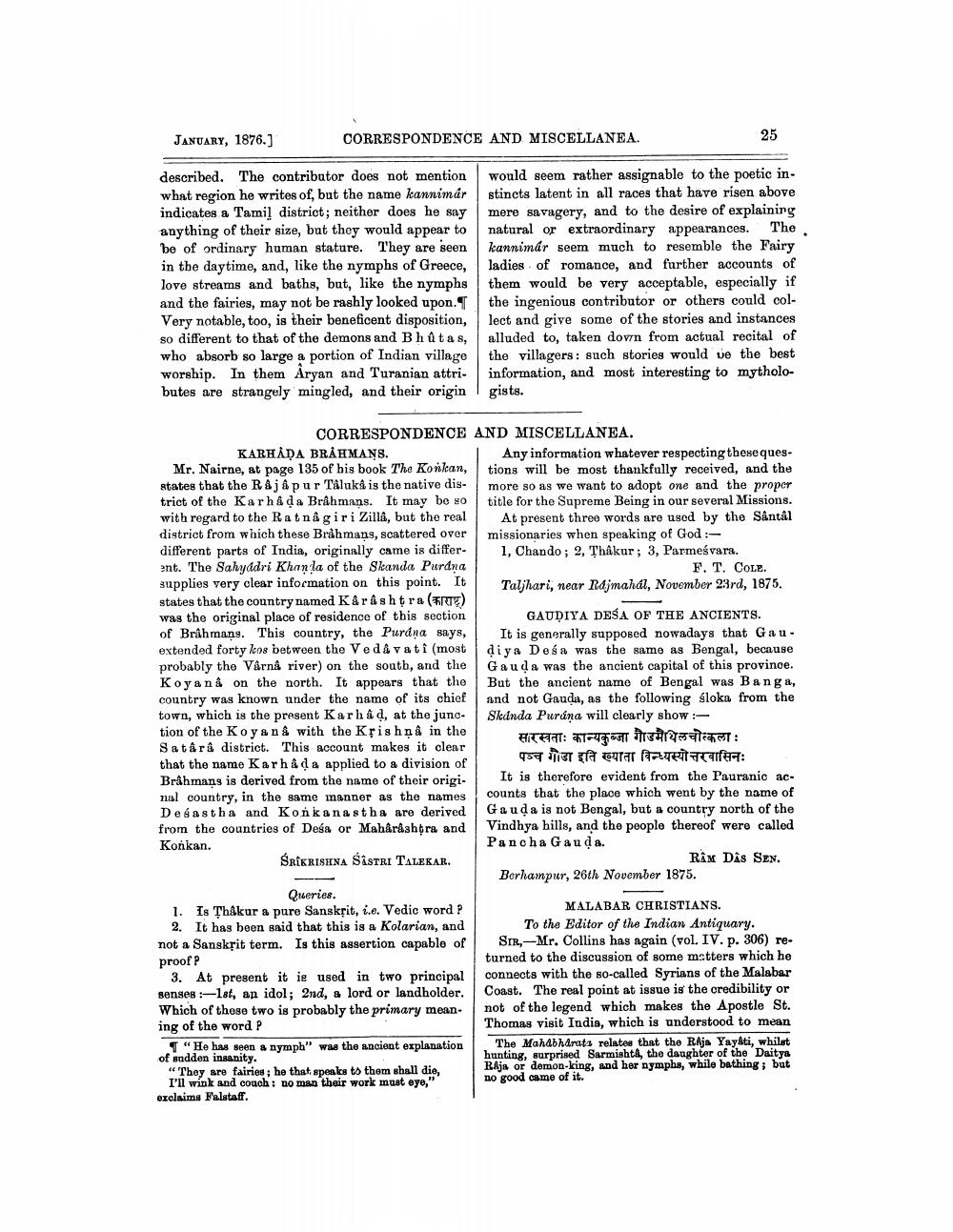________________
JANUARY, 1876.]
CORRESPONDENCE AND MISCELLANEA.
25
described. The contributor does not mention would seem rather assignable to the poetic inwhat region he writes of, but the name kannimar stincts latent in all races that have risen above indicates a Tamil district; neither does he say mere savagery, and to the desire of explaining anything of their size, but they would appear to natural or extraordinary appearances. The be of ordinary human stature. They are seen kannimar seem much to resemble the Fairy in the daytime, and, like the nymphs of Greece, ladies of romance, and further accounts of love streams and baths, but, like the nymphs them would be very acceptable, especially if and the fairies, may not be rashly looked upon. I the ingenious contributor or others could colVery notable, too, is their beneficent disposition, lect and give some of the stories and instances so different to that of the demons and Bhutas, alluded to, taken down from actual recital of who absorb so large a portion of Indian village the villagers : such stories would ve the best worship. In them Aryan and Turanian attri- information, and most interesting to mytholobutes are strangely mingled, and their origin gists.
CORRESPONDENCE AND MISCELLANEA. KARHÅDA BRAHMANS.
Any information whatever respecting these ques. Mr. Nairne, at page 135 of bis book The Konkan, tions will be most thankfully received, and the states that the Rajapur Taluka is the native dis- more so as we want to adopt one and the proper trict of the Karháda Brâhmans. It may be so title for the Supreme Being in our several Missions. with regard to the Ratnagiri Zillâ, but the real At present three words are used by the Såntál district from which these Bråhmans, scattered over missionaries when speaking of God :different parts of India, originally came is differ- 1, Chando; 2, Thâkur; 3, Parmeśvara. ent. The Sahyadri Khan la of the Skanda Purdna
F.T. Cole. supplies very clear information on this point. It
Taljhari, near Rajmahal, November 23rd, 1875. states that the country named Karashtra (T) was the original place of residence of this section GAUDIYA DESA OF THE ANCIENTS. of Brâhmang. This country, the Purana says, It is generally supposed nowadays that Gau. extended forty kos between the Vedavati (most diya Desa was the same as Bengal, because probably the Vârnâ river) on the south, and the Gauda was the ancient capital of this province. Koyang on the north. It appears that the But the ancient namo of Bengal was Banga, country was known under the name of its chief and not Gauda, as the following sloka from the town, which is the present Karhad, at the junc. Skúnda Purána will clearly show :tion of the Koyan & with the Kșishna in the
सरखताः कान्यकुब्जा गोडमैथिलचोकला: Satârâ district. This account makes it clear that the name Karha da applied to a division of
पञ्च गोडा इति ख्याता विन्ध्यस्योत्तरवासिनः Brahmans is derived from the name of their origi
It is therefore evident from the Pauranic acnal country, in the same manner as the namescounts that the place which went by the name of Desastha and Konkanastha are derived Gauda is not Bengal, but a country north of the from the countries of Desa or Maharashtra and Vindhya hills, and the people thereof were called Konkan.
Pancha Gauda. ŚRIKRISHNA SASTRI TALEKAR.
Ram Das SEN.
Berhampur, 26th November 1875. Queries. 1. Is Thâkur a pure Sanskrit, i.e. Vedic word ?
MALABAR CHRISTIANS. 2. It has been said that this is a Kolarian, and To the Editor of the Indian Antiquary. not a Sanskrit term. Is this assertion capable of SIR-Mr. Collins has again (vol. IV. p. 306) reproof
turned to the discussion of some matters which he 3. At present it is used in two principal connects with the so-called Syrians of the Malabar senses :- 1st, an idol; 2nd, a lord or landholder. Coast. The real point at issue is the credibility or Which of these two is probably the primary mean.
not of the legend which makes the Apostle St. ing of the word P
Thomas visit India, which is understood to mean T "He has seen a nymph" was the ancient explanation The Mahabharats relates that the Raja Yayati, whilst of sudden insanity.
hunting, surprised Sarmisht, the daughter of the Daitya "They are fairies; he that speaks to them shall die,
Raja or demon-king, and her nymphs, while bathing; but I'll wink and couch: no man their work must eye,"
no good came of it. exclaims Falstaff.




